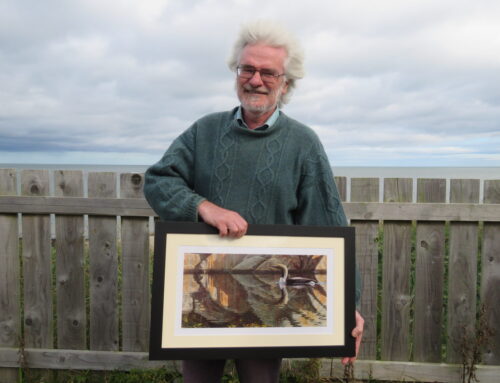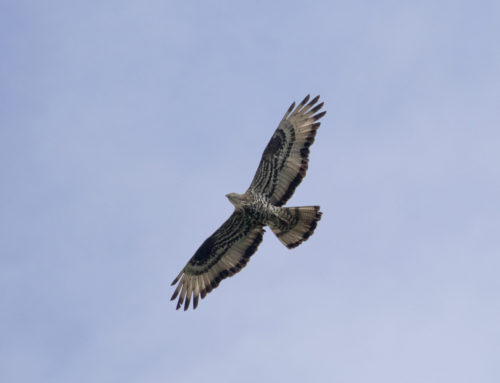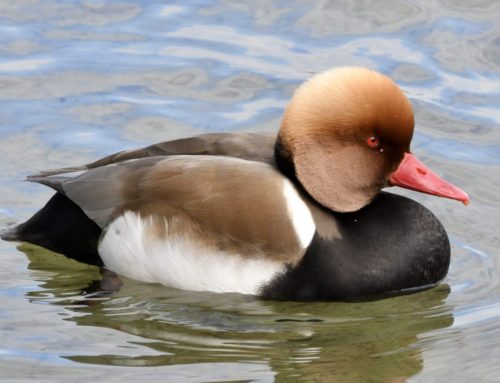The RBBP 50th anniversary conference – two great evenings!

As we hope you’re already aware, the Rare Breeding Birds Panel is celebrating a notable anniversary this year, 50 years on from the first meeting of the Panel as an independent organisation for the monitoring of rare breeding birds in the UK, in April 1973. We are marking this occasion in a number of ways – there are papers to come, website developments, new recording advice – the first of which was a conference held online on the evenings of 15th and 16th March.
We were nervous about this – it was the first ever RBBP conference, would anyone be interested, would we be able to master the technology? But we’re delighted to say it was a great success and a wonderful way to kick off our special year. The success was in large part due to the great selection of speakers we had. Three Panel members and ten other experts on various aspects of studying and conserving rare breeding birds, all of whom gave great talks. Combined with great chairing from Dawn Balmer and Ian Francis, and the enthusiastic supply of perceptive (96!) questions from the online audience, they made for two great evenings.
Even better news is that if you weren’t able to join us on the nights (258 did so on Wednesday, 217 on Thursday, and a total of 298 people over both nights) then recordings of the conference are now available on our youtube channel. You can watch the recordings for the entire evenings – Wednesday and Thursday – including chairing and the short Q & A sessions, or view the talks individually below.
We think it was a great event, and would like to express our thanks to the speakers who gave their time and expertise: Mark Eaton, Marcus Ward, Molly Doubleday, Sarah Anthony & Ali Giacomelli, Mark Mallalieu, Murray Orchard & Brian Watmough, Dawn Balmer, Amy Challis, Ian Carter, Ken Smith, Chantal MacLeod-Nolan and Mark Holling.
Wednesday started with a presentation from Panel Secretary Mark Eaton, focused on the basics of what the RBBP does, and how. Mark focused in particular on the sources of the data – around 9,000 records covering 25,000 breeding pairs in an average year – that the RBBP relies on, and paid tribute to all those who provide a huge amount of time and expertise to support our work. These include the past and present members of the RBBP, those who make annual submissions of data to the RBBP (with a big shout-out to the county bird recorders) and of course the thousands of observers who make records of rare breeding birds in the first place.
Following Mark we had the first of our species-focussed talks, with Marcus Ward from Wild New Forest telling us about his in-depth studies on Hawfinch in one of their remaining UK strongholds. Marcus’s talk started with describing roost studies, then moved to ringing, and then to the fascinating insights from following radio-tracked and GPS-tagged birds – where a pattern of behaviour was detected, only for some birds to behave completely differently! Marcus stressed there was much to learn, so we’ll have to invite him back next time we have a conference.
Our third talk was from Molly Doubleday, Capercaillie Advisory Officer for the RSPB. Molly told us about how this threatened grouse is monitored through winter surveys and lek counts – arduous work involving cold nights in uncomfortable tents although waking up to the sight and sound of displaying Capercaillie must be some compensation! She also talked about work being done to save this rapidly declining species, and the need to keep disturbance to a minimum – that include the need for birdwatchers not to seek out Capercaillie leks… “lek it be!”
After a short intermission (with a video montage of rare breeding birds) we were joined by a double act of Sarah Anthony and Ali Giacomelli from Natural England, who told us about the value of RBBP data in protecting sites for nature in England. Sarah illustrated how RBBP data, combined with data from a range of other sources, can be used to make the for the designation of sites – such as it was in the recent notification of the West Penwith Moors SSSI. Ali followed her to talk about how good quality bird data is then needed for the assessment of designated sites, and to indicate when action needs to be taken to keep them in good condition for the rare breeding bird populations they hold.
We then moved on to Mark Mallalieu, Chair of the Scientific Committee of the Sussex Ornithological Society, who after an interesting career is now focussing on birds in his home county in Sussex, with a particular focus on Honey-buzzard. Mark told us how his recent studies have found what appears to be an increasing population of breeding Honey-buzzards in the county, and ended by telling us of plans to publicise Honey-buzzard watchpoints in order to encourage safe and sensible interest in the species.
Closing our first evening was Murray Orchard, talking on behalf of himself and Brian Watmough about the work they do to submit rare breeding bird data from Kent. He talked us through the wealth of rare breeding birds Kent holds – despite the motorways, industry and solar farms – while pointing out how from a Kent perspective the term “rare breeder” can refer to quite a different suite of birds that are common elsewhere in the country. He then detailed the steps taken by he and Brian, and Kent Ornithological Society colleagues, to obtain rare breeding bird data from as many sources as possible to produce a robust dataset for annual submission to the RBBP.
The second evening started with a talk from RBBP Chair, Dawn Balmer, digging into what the RBBP’s data shows, and how it can be used for conservation and research purposes. She illustrated some of the ups – Spoonbill, Goshawk – and downs – Red-backed Shrike and Slavonian Grebe – in rare breeding birds over the last five decades, before going on to show how RBBP data are used for a wide range of purposes. These include Birds of Conservation Concern assessments, high-level reporting on the State of Nature, assessing the impact of species recovery projects, designating protected areas and research on the impact of climate change.
Second up was Amy Challis, who has been coordinator of the Scottish Raptor Monitoring Scheme since 2014. Amy gave an excellent overview of the SRMS, which supports monitoring of 19 raptor species (and Raven, an “honorary raptor”) by the Scottish Raptor Study Groups and is a crucial source of data for the RBBP’s reporting of rare raptors. She then went onto to present the new work, led by the BTO’s Mark Wilson, developing new trends (in both numbers but also measures of productivity) for Scottish raptors from the data that the SRMS collates.
Ian Carter was instrumental in the reintroduction of Red Kite in England, so was an ideal speaker to tell us about the recovery of this species and give some predictions for its future. The distribution remains patchy, and issues of persecution remain, but the UK population may now be around 7-8,000 pairs, and growing rapidly. Remarkably, the UK now has the second-largest population in the world. Given the ability of this species to “eat almost anything”, Ian predicts the population could reach 50,000 pairs or even more, and made a convincing case that it may regain its historical status as our most successful raptor.
Ken Smith – a RBBP linchpin for many years – was next up, to describe the monitoring work of the Woodpecker Network he and his wife Linda set up in 2015. This has driven a dramatic increase in the monitoring of Lesser Spotted Woodpecker, with 115 nests reported upon since then. Ken explained why this elusive species is such a “birding challenge”, before going on to describe how the RBBP could adapt its approach to enable the development of robust trends using occupancy modelling. He also espoused the idea of county surveys – a Hampshire survey in 2022 produced an estimate of 312 territories.
Our penultimate talk came from Chantal MacLeod-Nolan, who as a Project Officer at the RSPB has been behind a huge amount of work to help terns and other coastal species under a succession of EU-LIFE funded projects. Chantal described work under LIFE projects for Little and Roseate Terns, involving restoring sites, protection, and developing an international network. As is often the case, the involvement of volunteers (250+) has been hugely important. More recently Chantal has been delivering work for a wider suite of coastal species under the LIFE on the Edge project, and she shared details on some of the impressive habitat work that has been delivered at sites such as Hodbarrow and Titchwell.
The very last talk of the conference came from none other than Mark Holling, the RBBP’s longest-serving secretary and now RBBP Archivist. Mark gave a mouthwatering and handsomely illustrated run through the “rarest of the rare”, the species that have only occasionally bred in the UK, or simply just tantalised us with brief appearances. This ran from a range of species that have only graced RBBP reports as single singing males, to those that have succeeded in breeding, such as Spotted Sandpiper, a few pairs of Bluethroats, and colonists such as Cattle Egret. Mark provided a fitting note on which to end the conference.
If you attended the conference, many thanks for sharing our special occasion with us. If you didn’t, please enjoy catching up with the recordings above – they are all fascinating and informative. Once more, thanks to all our speakers.






